Sanskrit for Beginners Course
Based on “Introduction to Sanskrit” by Thomas Egenes.
Table of Contents:
NEW! Complete Sanskrit Grammar in a Fancy Table (IAST & देवनागरी)
SEMESTER 1:
Easy:
Intermediate:
Challenging:
- CH 8: Sandhi intro & types (external/internal) | Paradigm for Neuter nouns ending in “a”.
17 | 18 | 19 - CH 9: How to count (cardinal numbers) | Parasmaipada – Ātmanepada – Ubhayapada | Sandhi final “n/m”.
20 | 21 | 22 - CH 10: Sandhi final “t” | 1st (I: aham) – 2nd (you: tvam) – 3rd (he/she) person pronouns | Adjectives | Verb “asti”.
23 | 24 | 25 | 26 - CH 11: Stems ending in “ā” | Pronouns (He, she, with him, in that) | Word “iva” (like).
27 | 28 | 29 - CH 12: Stems ending in “i” | Numbers as Adj (numeral, cardinal, ordinal) | Gerunds (past tense).
30 | 31
SEMESTER 2:
- CH 13: Relative-correlative adverbs & pronouns.
32 | 33 | 34 - CH 14: Verbal prefix (PRATIgacchati) | Imperfect (past) for Parasmaipada.
35 - CH 15: Sandhi final “m” | Common verb prefixes | Imperfect (past) for Ātmanepada.
36 - CH 16: Sandhi final “n” | Nouns in -an (ātman, karman) | He/she/it was | Compounds: dvandva, itaretara, samāhāra, negative.
37 | 38 | 39 | 40 | 41 - CH 17: Nouns ending in ṛ ऋ (family words) | Future tense | Cardinal/Ordinal numbers.
42 | 43 | 44 - CH 18: Sandhi final “r” | Nouns ending in -u उ | Compounds: karmadhāraya, tatpuruṣa, upapada, bahuvrīhi, dvandva | VOL1 Recap.
45 | 46 | 47 | 48 | 49
SEMESTER 3:
- CH 19: Suffix (mat/vat, tva/tā, ya) | Imperative (“He must go!”) | Upapada compound.
50 | 51 | 52 | 53 - CH 20: Verb class 1, 4, 6, 8, 10 | Passive (“is protected”).
54 | 55 | 56 - CH 21: Verse memorization | Nouns ending in -as (manas) | Bahuvrīhi compound.
57 | 58 | 59 | 60 | 61 - CH 22: Sanskrit origins | Past passive participle (-ed) | Verb class 3 | Reduplication | Prefix (su, dus).
62 | 63 - CH 23: Suffix (-in) | More Verb class 3 | Verb class 7.
64 | 65 - CH 24: Periphrastic Future | Future Passive Participle (Gerundive) | Verb class 5.
66 | 67
SEMESTER 4:
- CH 25: Pronominal Adjective | Verb Class 2 & 9 | Summary of 10 Verb Classes
68 - CH 26: Perfect | Optative | Interrogative & Indefinite Pronouns
69 - CH 27: Stems ending in c/t/d | Infinitive (‘to go') | ‘This' (etad)
70 - CH 28: Present Participle (-ing)
71 - CH 29: Causative | ‘This' (idam)
72 - CH 30: Suffixes | Adverbs | Desiderative (He wants to eat)
73 - CH 31: Intensive | Denominative | Aorist | Conditional | Past Participle | Future Participle | Cardinal Numbers
74
Course has concluded!



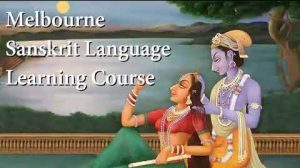


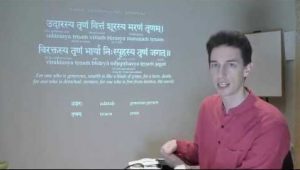




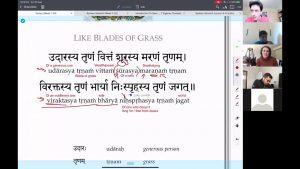



















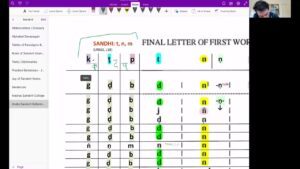







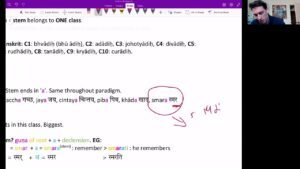
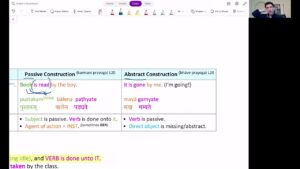









Dear Andre
one doubt please
lesson 11 exercise 2 , H
with knowledge the students obtains immortality .
Gyanen sah shishyah amratam labhte
vidhya shishyo amratam labhte (according to book)
ARE these both correct ???
Yes both are correct.
विद्यया सह (OR) ज्ञानेन सह
http://yesvedanta.s3.amazonaws.com/sanskrit/little-red-book-sanskrit-devanagari-mccomas-taylor.pdf
LRB sanskrit version
for whole group , few students were requesting .
tx
I will follow your classes on sanskrit offline.
Namo Namah Andrei
lesson 13
Q1 ,E
two friends should it be Mitrau ( as nar paradign for dual ??)according to answer it is mitraih???
kripya explain
mitre: Two friends.
mitrau = incorrect. As “au” only applies to Masculine words like “narau”.
Hi Andre
Some questions about the homework.
1. The answers to lesson 13 in the book write ‘patnī’ in 2 different ways. Are there two different ways to write the conjunct consonant ‘tna’ ?
2. 2(g) says – The student, having thought, asks the poet about the river.
I rewrote the sentence to say – Having thought, the student asks the poet about the river – matvā śiṣyo nadīṁ kaviṁ pṛcchati
This is not the order of words in the answer but is it acceptable?
======
1) ‘patnī’ in 2 different ways.
======
Here’s two different ways to write “tna” in devanāgarī: https://i.imgur.com/Yws9iBt.png
Both are correct.
====
2: I rewrote the sentence to say – Having thought, the student asks the poet about the river
====
Perfect. That’s how I would’ve done it.
HI Andre
is there a way to get the link which Shiva shared for the Bhagvat Geeta with Sandhi .
I saved his link but unable to locate it .
Thanks
BGita without Sandhi: https://drive.google.com/file/d/1wKKFaRdW9-Qajhooxz2vdnkML_vuDil1/view?usp=sharing
Since it’s in IAST. Just copy paste desired text in IAST section at: yesvedanta.com/transliterate to get Devanagari.